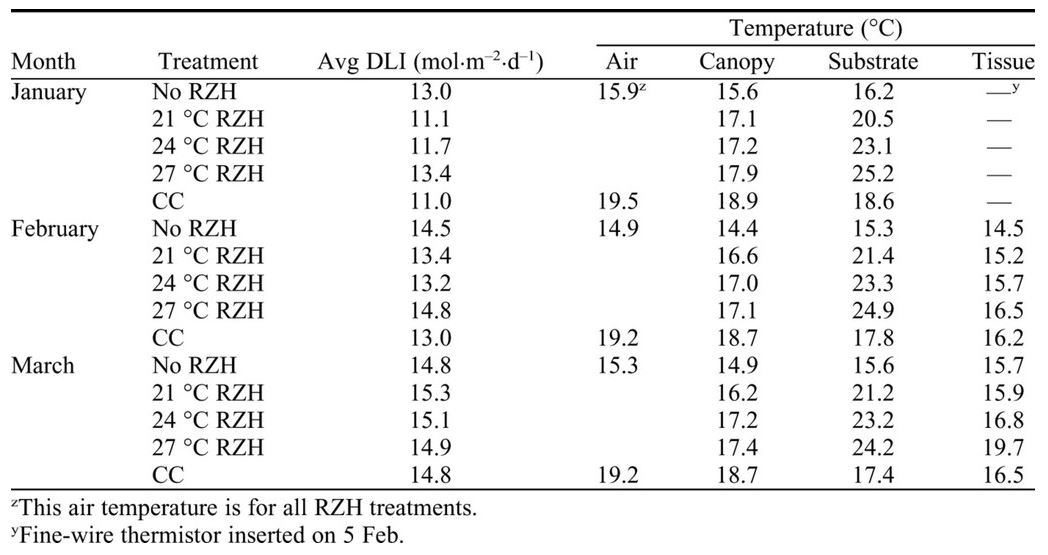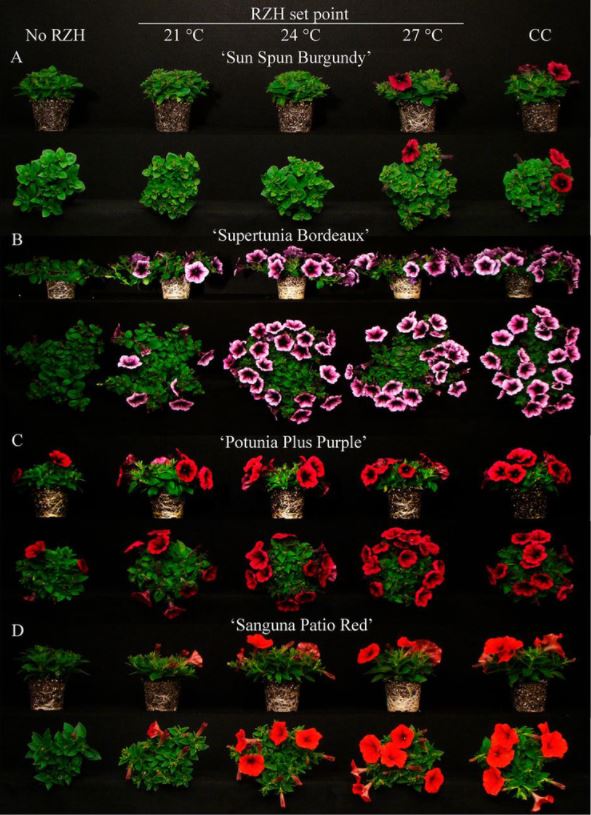D.evelopment of Petunia
密歇根州立大学的研究人员使用了Apogee ST-100,ST-110和ST-110热敏电阻,研究了台式根源促进对矮牵牛生根切割和幼苗的发展的影响(喇叭花是最受欢迎的床上用品植物在美国出售)。该研究于2017年1月在Hortcience期刊上发表。
矮牵牛植物在两种单独的温室中生长,暴露于不同的温度处理,并且前端的热敏电阻测量了基板温度(ST-100high accuracy thermistor in waterproof housing), plant tissue temperature (ST-200.细丝热敏电阻),以及冠层空气温度(ST-110每种处理中的高精度热敏电阻。研究人员发现,在较低的空气温度下,在较高的根温度温度下升起了花的时间。这意味着通过降低温室空气温度的生产时间和潜在节能的温室运营,增加节省。研究人员还发现,随着根区加热的较低空气温度生长的植物总体上是较小的植物尺寸,这对于种植者而言,由于植物占据了更少的生产长凳空间,因此被认为是有益的。
阅读更多关于以下研究的信息。


表格1。平均每日透光整体(DLI)和日常空气,树冠,底座和植物组织温度,每次治疗,每月进行移植后。植物在15℃的平均日温度(MDT)的平均每天温度(MDT)中生长,并且植物置于没有根区加热(NO RZH)的长凳上,或者具有21,24或27℃的RzH设定点;或根据商业对照(CC),在20°C的MDT的MDT的温室中生长或植物。
抽象的:Heating accounts for up to 30% of total operating costs for greenhouse operations in northern latitudes. Growers often lower air temperatures for production to reduce energy costs; however, this causes delays in development even in cold-tolerant crops, such as petunia(Petunia ×hybrida)。这延迟增加了生产时间和红色uce profitability. Recent studies on low air temperature bedding plant production indicate petunia as a strong potential candidate for using lower air temperatures in combination with bench-top root-zone heating (RZH) to avoid or reduce delays in development. The objectives of this study were to 1) quantify time to flower (TTF) of seven petunia cultivars and two recombinant inbred lines (RILs) when the mean daily air temperature (MDT) was lowered by 5 °C and bench-top RZH was used and 2) determine if a high-quality petunia crop can be produced on RZH. Petunia ‘Sun Spun Burgundy’, ‘Sun Spun Lavender Star’, ‘Sanguna Patio Red’, ‘Potunia Plus Red’, ‘Potunia Plus Purple’, ‘Supertunia Red’, ‘Supertunia Bordeaux’, and two RILs, IA160 and IA349, were grown in a greenhouse with an MDT of 15 °C without RZH or with a RZH set point of 21, 24, or 27 °C. Additionally, a commercial control (CC) was established by growing plants without RZH at an MDT of 20 °C. All plants were grown under a 16-hour photoperiod to provide a daily light integral (DLI) of ≈12 mol m-2D.-1。RZH设定点的花时间短。例如,在15℃的MDT的植物,“Potunia Plus Red”的TTF为56,52,49,或47天,其MDT在15°C的植物中没有RZH,或分别为21,24或27℃的RZH设定点。当使用RZH设定点27°C时,除了“Potunia Plus Red”和'Sanguna Patio Red'之外,所有品种和自交系的TTF类似于CC生长的植物。在较低空气温度下与RZH的较低空气温度下生长的植物,观察到较短的茎长,较低的生长指数和较小的芽干肿块(SDM),导致更紧凑,优质的植物。在较短的时间内生产紧凑型植物对种植者有益;因此,结果表明,当采用27℃的RZH设定点时,MDT可以降低到喇叭花生产的15°C。

Fig. 1.喇叭花(一种)'太阳旋转勃艮第',(B.)'Supertunia Bordeaux',(C)'potunia plus purple',和(D.)“Sanguna Patio Red”在移植后7周。植物在15℃的平均日温度(MDT)的平均每天温度(MDT)中生长,并且植物置于没有根区加热(NO RZH)的长凳上,或者具有21,24或27℃的RzH设定点;或植物在温室中生长,在20°C的MDT的RZH,作为商业对照(CC)。
